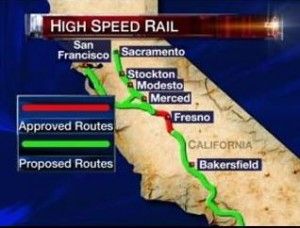State Senate hearing casts doubt on high-speed rail
by Kathy Hamilton | April 7, 2014 12:06 pm
 [1]Editor’s Note: This is Part 1 of a series looking in depth at the latest hearing in the state Senate on California’s high-speed rail blueprint.
[1]Editor’s Note: This is Part 1 of a series looking in depth at the latest hearing in the state Senate on California’s high-speed rail blueprint.
California’s high-speed rail project keeps running into obstacles along its track to construction.
The March 27, 2014 hearing of the Senate Transportation and Housing Committee[2] reviewed the 2014 Draft Business Plan[3] and evaluated the project’s potential for success. The hearing was expected to showcase strong support for the train, but that was not the case. Even the public comments time was devoid of the usual lineup of pro-train advocates.
The only committee member actually at the hearing was its chairman, state Sen. Mark DeSaulnier[4], D-Walnut Creek.
CalWatchdog.com insisted that the hearing be put on video[5]. The committee staff made that happen at the last minute.
Experts from academia, the train supporters’ group Rail Pac and the Legislative Analyst’s Office delivered what many already knew: This train project has severe issues, including capital cost shortfalls, operations and maintenance shortfalls, bond measure compliance challenges and route issues.
The committee handed out a “Background Paper[6],” which laid out groundwork for the hearing:
“This Informational Hearing will review the Draft 2014 Business Plan[7]; consider the potential of this plan to promote the long-term success of the high-speed rail project in the face of current and pending legal, economic and policy challenges; and consider changes or alternative pathways for inclusion in the Final 2014 Business Plan and beyond. This hearing is intended to help guide a high-speed rail project that can be the centerpiece of a world-class passenger rail system in California.”
Ibbs testimony
A key expert testifying was William Ibbs[8], a professor at the Department of Civil and Environmental Engineering at the University of California, Berkeley. A video of the testimony by itself is here[9]. Among other qualifications, he has benchmarked more than 2,000 large-scale construction projects around the world.
Ibbs suggested the state might “revisit the question of whether we should be devoting this much money to a high-speed rail system when we have pressing problems with our highways and airports.”
He brought up the problem of recouping costs. “Most rail systems in the U.S. collect only about two-thirds of their operating cost from the fare box,” he said. “If we have that kind of experience on this project, it’s going to eat future generations alive, it’s going to eat our grandchildren’s wallets alive.”
Proposition 1A[10], the 2008 initiative voters passed that green-lighted the project, forbids the state from subsidizing operational costs.
“A lot more people will use highways than any railroad system,” Ibbs pointed out. “So I would urge you and your colleagues to look at transportation investment across the board and give us a world-class transportation system.”
Capital investment
He didn’t give a number for what he expected the finished high-speed rail project would cost. But he suggested that capital investment would be substantially more than the $68 billion projected in the 2014 Draft Business Plan[3].
Ibbs said he studied how the “capital costs skyrocketed on projects like the Big Dig[11] [tunnel in Boston] and the Bay Bridge[12] — even higher than the system critics would have ever envisioned.”
Ibbs also suggested the Senate require a “scenario analysis” on both capital costs and operations and maintenance costs. He believes the operations costs can be more problematic than the capital costs.
That’s because, for capital expenditures — building the tracks and buying the trains — the costs stop when the project is finished, unless the tracks later are extended to new routes. But operating costs and maintenance continue so long as the train does, and such costs can go up from such things as inflation and higher labor contracts.
Moreover, if ridership is not as high as expected, the operations and maintenance costs still must be paid. If ticket prices are raised to pay for the higher costs, then ridership can drop further, with people instead taking airplanes or driving their cars.
The future will change technology
Ibbs brought up a quote attributed to Microsoft co-founder Bill Gates, “Over three years, things change much slower than we expect. But over the course of 10 years, things change much more dramatically than we can ever imagine.”
Ibbs suggested that a 30-year horizon brings multiple generations of technological changes. Kids these days easily use Skype, GoToMeeting and other programs instead of face-to-face employer interviews.
Ibbs brought up entrepreneur Elan Musk’s Hyperloop[13] train and Google’s self-driven car, two innovations that might be developed quickly in the coming decades. But Ibbs wondered if people might feel a bit claustrophobic in a Hyperloop tube being shot across California, a different experience from a more traditional train like high-speed rail.
- [Image]: http://calwatchdog.com/wp-content/uploads/2013/08/high-speed-rail-map-320.jpg
- hearing of the Senate Transportation and Housing Committee: http://senate.ca.gov/vod/20140401_1337_STV1Vid
- 2014 Draft Business Plan: http://www.hsr.ca.gov/About/Business_Plans/Draft_2014_Business_Plan.html
- state Sen. Mark DeSaulnier: http://sd07.senate.ca.gov/
- put on video: http://senate.ca.gov/vod/20140401_1337_STV1Vid
- Background Paper: http://stran.senate.ca.gov/sites/stran.senate.ca.gov/files/BackgroundPaper3-27-14_Final_amended.pdf
- Draft 2014 Business Plan: http://www.hsr.ca.gov/About/Business_Plans/Draft_2014_Business_Plan.html
- William Ibbs: http://www.ce.berkeley.edu/~ibbs/
- here: https://www.youtube.com/watch?v=pHvBZo8JW7Q&feature=youtu.be
- Proposition 1A: http://ballotpedia.org/California_Proposition_1A,_High-Speed_Rail_Act_(2008)
- Big Dig: http://en.wikipedia.org/wiki/Big_Dig
- Bay Bridge: http://www.sfgate.com/bayarea/matier-ross/article/Bay-Bridge-cost-driven-up-by-politics-4778352.php
- Hyperloop: http://www.shalomlife.com/business/22694/the-first-hyperloop-will-take-place-in-israel-2015/
Source URL: https://calwatchdog.com/2014/04/07/state-senate-hearing-casts-doubt-on-high-speed-rail/